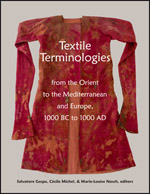Centre for Textile Research
Date of this Version
2017
Document Type
Article
Citation
In Textile Terminologies from the Orient to the Mediterranean and Europe, 1000 BC to 1000 AD, ed. Salvatore Gaspa, Cécile Michel, & Marie-Louise Nosch (Lincoln, NE: Zea Books, 2017), pp. 202-211.
doi:10.13014/K26T0JS4
Abstract
The study of written sources of the Classical period (5th and 4th centuries BC) reveals the existence of a very rich vocabulary related to textile production. There are terms referring to materials, tools, manufacture and decoration techniques, colours, people and places related to textile manufacture. Many terms are quite clearly defined, while others present major difficulties in their interpretation. Usually these concern terms for tools, such as κερκίς (pin beater or shuttle) and ἡλακάτη (distaff or spindle) or terms describing fabrics with some kind of decoration. Among the decorative terms, some refer to specific decorative techniques, such as κατάστικτος (embroidered) while others refer to aesthetic results, such as ποικίλος (with elaborate and colourful decoration).2 I believe it is quite important at this point to underline a significant characteristic of the ancient Greek language. Although languages are not simply univocal codes and their meaning is the most important dimension, ancient Greek has what may be called an indivisible polysemy of words (and grammatical cases). Its semantic richness cannot be compared to modern European languages, such as English.3 In this context, one and the same ancient Greek term can include more than one meaning simultaneously (e.g., ὥρα = time, season, youth, perfect moment), in which case the translator does not have to choose between the different meanings, because they are all included – or the same term can have different meanings depending on the context (e.g., ὀργή = anger, wrath, but also drive, impulse, temperament, outburst), in which case the translator has to choose the right meaning. This could lead to difficulties in the lexical field of textiles and textile production. Very often a single term creates semantic harmonics, which produce in the mind of the listener a series of mental associations through its resonances, consonances and connotations. In order to understand a term, one has to clarify its entire semantic potential. Furthermore, each term must be interpreted in relation to its context as opposed to adopting an univocal or unambiguous meaning. This kind of ambiguity certainly does not apply to every single term. For example, terms for weaving tools must have been clearly defined in Antiquity, although they often seem ambiguous to us today.
In this chapter I am going to discuss the term μίτος, core term of a family of words with many composita, such as εὔμιτος, λεπτόμιτος, τρίμιτος, πολύμιτος and derivatives, such as μιτώδης, μίτινος and τριμίτινος. The term μίτος is without known etymology as per all recent etymological dictionaries and accordingly without convincing explanation about its original meaning. In time it came to refer to the thread in general, ἀγαθὶς μί(λ)του,6 ‘ball of thread’. The term seems to change meaning depending on the compositum (in the case of λεπτόμιτος we are certain that this term refers to a fabric created with fine threads, but in the case of τρίμιτος for example, we are not sure of the meaning of the term μίτος). From all these related terms, I have chosen to examine the terms μίτος => τρίμιτος / τριμίτινος => πολύμιτος. These terms contain the term μίτος and, moreover, they refer to multiples of μίτος. I think it is important to try to elucidate both the meaning of the core term, and that of its composita.
Included in
Ancient History, Greek and Roman through Late Antiquity Commons, Art and Materials Conservation Commons, Classical Archaeology and Art History Commons, Classical Literature and Philology Commons, Fiber, Textile, and Weaving Arts Commons, Indo-European Linguistics and Philology Commons, Jewish Studies Commons, Museum Studies Commons, Near Eastern Languages and Societies Commons, Other History of Art, Architecture, and Archaeology Commons


Comments
Copyright © 2017 Salvatore Gaspa, Cécile Michel, & Marie-Louise Nosch. Photographs copyright as noted.